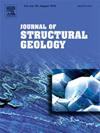多层前陆序列中断层生长的岩性控制和结构传承
IF 2.6
2区 地球科学
Q2 GEOSCIENCES, MULTIDISCIPLINARY
引用次数: 0
摘要
随着造山楔的迁移,前陆区和前深海-前深海系统会受到连续阶段的应力状态和构造变形的影响,从而形成复杂的断层网络,即使其变形程度有限。结构继承和应力场随时间的变化在影响断层段连续重新激活方面所起的作用仍是一个有待深入研究的课题。在这项研究中,得益于 Energean 公司提供的大量数据库,我们得以对亚平宁半岛南部边缘的一个前陆区进行研究。通过对新近纪前深部序列的厚度分析和沿断层网络的位移分析,我们记录了从赞克利期与前深部有关的延伸到皮亚琴察期以来与走向滑动应力场有关的新构造阶段的转变,这可能与特雷米蒂断层带的活动有关。我们还描述了覆盖层受限断层的几何形状和连通性,这些断层发育在正断层之上,并观察到断层扩展趋势与覆盖层单元内的岩性/力学分层之间存在明显的相关性。本文章由计算机程序翻译,如有差异,请以英文原文为准。
Lithological control and structural inheritance on faults growth in multilayer foreland sequences
Foreland sectors and foredeep-forebulge systems are affected, as the orogenic wedge migrates, by successive stages of stress states and tectonic deformation, resulting in the development of complex fault networks, even if characterized by limited deformation. The role played by structural inheritance and changes in stress field through time, in influencing the successive re-activations of fault segments, is still a topic to be thoroughly investigated. In this work, thanks to an extensive database made available by courtesy of Energean, we were able to investigate a foreland sector at the margin of the southern Apennines. By means of thickness analysis of the Neogene foredeep sequence and of displacement analysis along the fault network, we documented a shift from forebulge-related extension, in Zanclean, to a new tectonic phase, since Piacenzian, related to a strike slip stress field, possibly related to the activity of the Tremiti Fault Zone. We also characterized the geometry and connectivity of the cover-restricted faults, developing above propagating normal faults and observed a clear correlation between fault propagation tendency and lithological/mechanical layering within the cover units.
求助全文
通过发布文献求助,成功后即可免费获取论文全文。
去求助
来源期刊

Journal of Structural Geology
地学-地球科学综合
CiteScore
6.00
自引率
19.40%
发文量
192
审稿时长
15.7 weeks
期刊介绍:
The Journal of Structural Geology publishes process-oriented investigations about structural geology using appropriate combinations of analog and digital field data, seismic reflection data, satellite-derived data, geometric analysis, kinematic analysis, laboratory experiments, computer visualizations, and analogue or numerical modelling on all scales. Contributions are encouraged to draw perspectives from rheology, rock mechanics, geophysics,metamorphism, sedimentology, petroleum geology, economic geology, geodynamics, planetary geology, tectonics and neotectonics to provide a more powerful understanding of deformation processes and systems. Given the visual nature of the discipline, supplementary materials that portray the data and analysis in 3-D or quasi 3-D manners, including the use of videos, and/or graphical abstracts can significantly strengthen the impact of contributions.
 求助内容:
求助内容: 应助结果提醒方式:
应助结果提醒方式:


